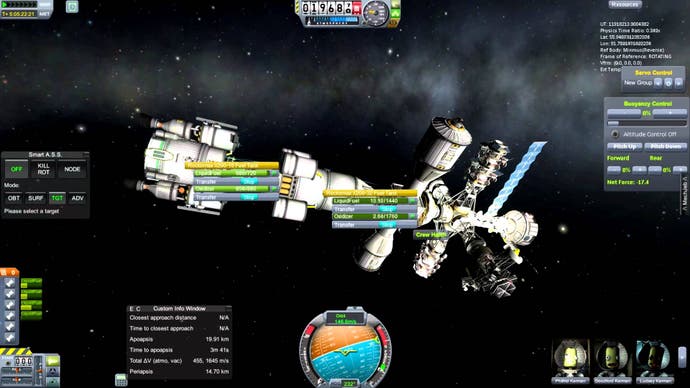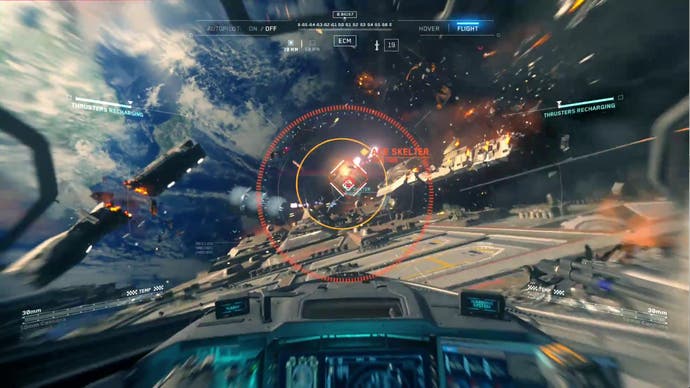On NASA, the video game developer
Get your ass to Mars.
From the austere Newtonian universe of Spacewar! to the lush galactic disc of Mass Effect, video games have been taking us beyond Earth's atmosphere for decades, but in the eyes of Dr Jeff Norris of the US National Aeronautics and Space Administration, few have done the spirit and practicalities of space travel justice. Speaking at this February's DICE summit in Las Vegas (video below), Norris threw down something of a gauntlet. "If you'd like games to be recognised as a great form of art, I'm afraid that some of you, not all of you, are going to need to step it up. You see, great art, doesn't just move us as individuals, it can move entire societies." For Norris, art has worth when it's bringing about "riot and revolution", when it furthers some broader cultural or political enterprise - an enterprise such as NASA itself, which has long relied upon dreamers of all kinds to relay its values and significance to the world at large.
As an example of such inspirational artistry, Norris took his audience through the work of Chesley Bonestell - the science-fiction illustrator whose opulent yet plausible renderings of rocketships and distant planetscapes helped make the case for the creation of NASA in the late 1950s. His paintings, many published in a Colliers' Magazine article series entitled "Man Will Conquer Space Soon!", are the result of meticulous research and discussion with pivotal scientists such as the former Nazi engineer Wernher von Braun, who would design the rockets that propelled NASA's Mercury, Gemini and Apollo astronauts into orbit. Having surrendered to the US army in 1945, von Braun spent much of his post-War career battling apathy toward the idea (or at least, the expense) of space exploration while developing the USA's first intercontinental ballistic missiles. He glimpsed in Bonestell's concept illustrations an opportunity to swing popular opinion and thus, Congress behind his visions of orbital installations and expeditions to the Moon, a tactic NASA would return to in the decades to come.
Norris wants video games to pick up the baton from Bonestell. He's eager to play titles that treat interplanetary travel not as an entertaining fantasy, but "something we could reach, something we could do, and should do - something that was almost our birthright, something whose time had come". To that end, he and NASA have collaborated with Blackbird Interactive, developer of Homeworld: Deserts of Kharak, to construct a simulation of a hypothetical 22nd century Martian colony in the Gale Crater, near the landing site of the Mars Curiosity rover. Titled Project Eagle in a nod to the Apollo 11 Lunar Module, this far-flung interactive diorama is a work of creeping hyperreality - that's to say, it troubles the distinction between reality and representation.

Some elements of the simulation draw upon NASA's satellite imagery and research into the planet's composition: the base is built over an aquifer, with algae gardens to produce oxygen and mining works to extract sulphur for concrete. But there's also the echo of the Homeworld series in the use of a holographic map, complete with that familiar bass dip when you open the interface, and a graceful blue-orange-white palette. And in the echo of Homeworld, you might hear echoes of NASA's wide-ranging, strategic investments in the art world. The agency founded an in-house Art Program in 1962 which still operates today, commissioning such luminaries as Andy Warhol and Annie Leibovitz to provide what James Webb, NASA administrator at the time, called "a unique insight into significant aspects of our history-making advances into space". Many of the associated pieces are housed at the Smithsonian in Washington D.C., where they serve as a potent affirmation of NASA's centrality to the American project.
Even if you disregard that heritage, the Martian crust may strike you as oddly familiar - it has, after all, been copiously mapped and photographed for dissemination on social media, in a bid to make treading the soil of an alien planet seem as natural - and inevitable - as scrolling a feed. Project Eagle is, in other words, not so much an educated daydream about a voyage to Mars as an unwitting, layered exploration of how NASA has colonised the art and media landscape, in order to maintain its status amid the shifting tides of US public sector policy. Particularly revealing is the monument to the Curiosity rover placed in one corner - a poignant little touch which doubles as a rebuke to those who'd rather the $2.5 billion spent on Curiosity had been reserved for more prosaic, Earthly concerns, such as hospitals or urban infrastructure.
As with popular art in general, NASA's contributions to and impact upon video games are considerable, dating way back to the appearance of the first video game consoles in the 1980s. One recent example is Call of Duty: Infinite Warfare, whose starships and equipment were designed with the aid of NASA consultants. Anti-gravity gunplay and the pageantry of a cruiser's flight deck aside, the game's campaign involves a trip to a lunar base where you'll pass through an exhibition of 20th century space technology, including what looks like a replica of the Sojourner rover. NASA has also published a number of games of its own - it had a full-blown MMO called Starlite on the boil at one stage - and in 2013, approached the creators of the Kerbal Space Programme with a view to adding branded components to its ship-building toolset.

Many of these interventions are carried out with noble intentions, of course. NASA's ranks are stocked with idealists, anxious to preserve what they see as a vital human legacy, and its ventures into video games are as much designed to shore up waning interest in maths and the sciences as they are a means of spreading the gospel. But we are fundamentally talking about a government institution seeking to co-opt an artform for its own ends - and it's important to recall, in the face of such concerted self-promotion, that NASA has its dark side.
Amid all the rhetoric about mysterious frontiers and the spirit of discovery, it's easy to forget that the agency owes its existence primarily to the perceived threat of a Soviet attack from orbit. That's certainly the impression you might derive from that celebrated Colliers' Magazine series - as breath-taking as Bonestell's illustrations are, the accompanying text is heavy with Cold War dread, prompted by the Soviet Union's launch of Sputnik 1 (the world's first artificial satellite) in 1957. "A ruthless foe established on a space station could actually subjugate the peoples of the world," warns the introductory editorial. "Sweeping around the earth in a fixed orbit, like a second moon, this man-mad island in the heavens could be used as a platform from which to launch guided missiles. Armed with atomic warheads, radar-controlled projectiles could be aimed at any target on earth's surface with devastating accuracy." It was this frisson of terror, rather than the lure of a starlit yonder, that persuaded President Eisenhower to sign the National Aeronautics and Space Act in 1958. But for the long shadow of Sputnik, Neil Armstrong's saunter across the Sea of Tranquility might never have occurred.
While founded on paper to explore space for peaceful purposes, NASA has enjoyed and continues to enjoy a close relationship with the armed forces - many of the first astronauts were naval test pilots, and the agency routinely shares hardware and intelligence materials with the US military. It is, of course, notable that much of the rocket technology used to put human beings in orbit has also gone into the construction of ICBMs. Von Braun's chilling remarks with regard to Germany's first successful V2 missile launch, "the rocket worked perfectly, except for landing on the wrong planet", are a reminder that space exploration and military adventure are two sides of the same coin.
As a cultural totem, NASA has also served to calcify certain social prejudices or stereotypes. The Mercury, Gemini and Apollo astronauts were groomed to be models of American masculinity, clean-shaven Anglo-Saxon heroes with firm handshakes and compliant, photogenic wives. It wasn't till 1983 that NASA's first African-American and female astronauts took flight. However much we delight in representations of distant realms, we should be cautious of such an entity's interest in video games - much as we should be cautious of how arms manufacturers use shooters like Call of Duty to promote their wares, or of Big Pharma's discovery of video games as "digital therapies".

Above all else, we should resist efforts to reduce art to the status of a cog in the machinery of innovation or conquest. Art can make the wonderful seem possible - it can turn the unimaginable into something practical, tactile, and in the context of a climate crisis whose effects are terrible yet diffuse and elusive, there is certainly call for art that can escape Earth's gravity and consider human civilisation from on high. But art risks losing its way when it steps up in the service of an agenda, and all such projects should be treated with a healthy measure of suspicion.


